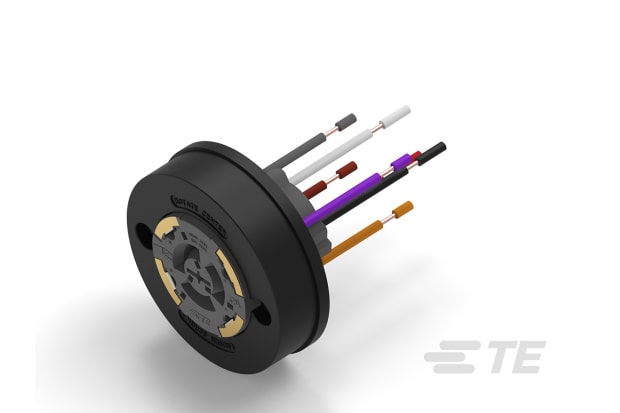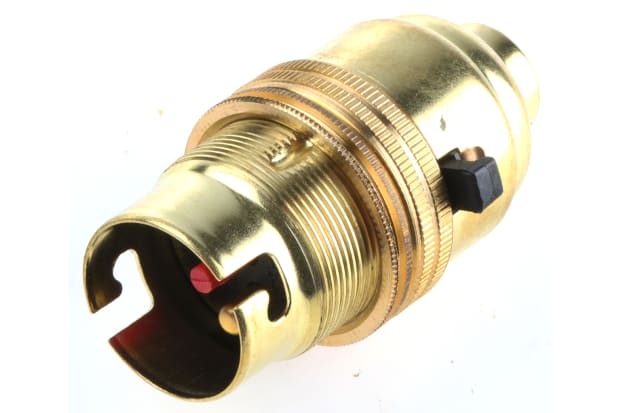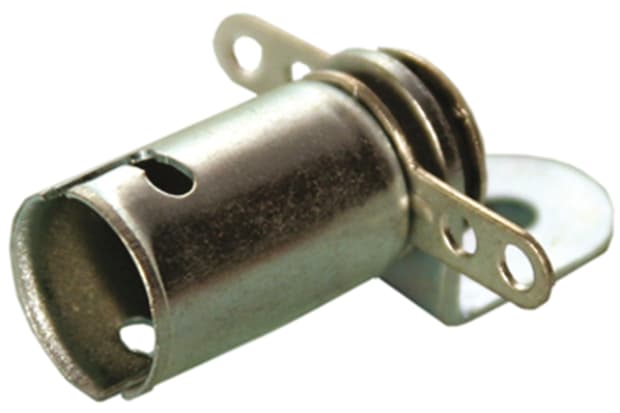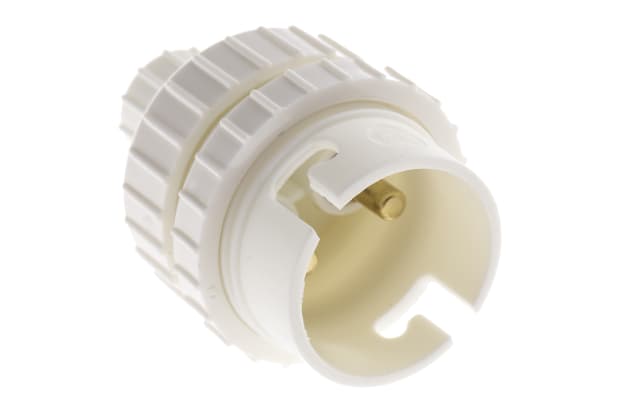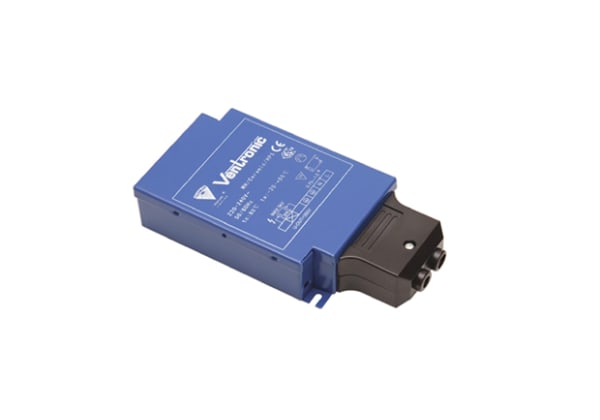- Published 24 Jan 2023
- Last Modified 29 Aug 2023
- 9 min
A Complete Guide to Lamp Holders
Read our lamp holders guide to learn the main types and features, common sizes, materials, and how to wire them.

What is a Lamp Holder?
These lighting components are a familiar feature of every home, factory and office. They hold light bulbs in place and provide an electrical connection to power them. Some light sockets include a switch to power on the bulb while others do not.
Lamp holders come in a variety of shapes and sizes and sometimes support other accessories or parts of the fixture such as light shades. They have several alternative names, including light sockets, lamp fittings, light holders, and bulb holders.
Lamp holders are designed to fit specific light bulb sizes and cap types and they will not fit any others, so always check this carefully. Amongst the most widely used bulb types are:
GLS
What is a GLS bulb? General Lighting Service bulbs feature the familiar, basic, pear-shaped design that has been in use for more than a century. They may have either bayonet or screw caps.
CFL
Compact fluorescent lamp bulbs are the energy-saving successor to traditional bulbs. Instead of a burning filament, they contain mercury vapour which emits ultraviolet light in response to electrical current. This UV light, in turn, triggers a coating of phosphorus within the bulb to glow, emitting light. Typically, CFL bulbs feature various stick and spiral shapes but traditional pear designs are also available.
LED
Light-emitting diode bulbs are the next step beyond CFL lighting. Extremely energy-efficient and with long lifespans, they provide instant-on lighting. They are built around a semiconductor, a device with electrical conductivity halfway between metal and insulation. This emits light in response to electrical current.
Lamp Holder Types
Lamp holders are available in a variety of designs for different uses. Let’s take a look at the main types of holder for lamps:
Lamp Holders for Table Lamps
Lamp holders for table lamps are relatively simple, upright devices which may feature all major mount types. Some table lamp holders come with switches for easy control.
Batten Lamp Holders
Batten lamp holders are small, screw-on devices that can be attached to a door or wall fitting vertically. They are available with Edison screw and bayonet cap mounts, in white, black and other colours.

GLS Lamp Holders
GLS lamp holders are versatile workhorses, housing the oldest and most familiar of bulb designs, the General Lighting Service pear bulb.
Lamp Holders for Bottles
Lamp holders for bottles create eye-catching lighting. A cable and switch are threaded through a hole drilled into the base of an empty bottle. This then extends up to a bulb holder inserted into the neck. As these are primarily decorative lamps, a variety of cable colours and switch colours are available.
Pendant Light Fittings
Pendant light fittings and parts are made for suspended ceiling lamps. They hang from a cord or cable and the bulb is inserted by pushing or screwing directly from below.
Switched Lamp Holders
Switched lamp holders feature built-in power switches as an alternative or addition to the main lamp switch.
Fixing Methods and Lamp Holder Mounts
The technique required for fixing bulbs into lamp holders varies according to bulb type and lamp holder mount - i.e. the type of connection.
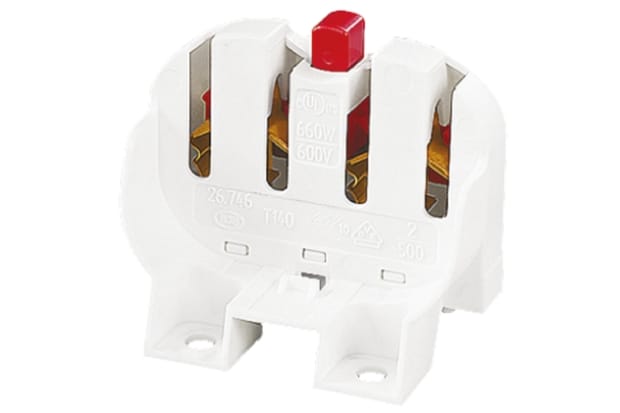
Push Fit
Push-fit mounts are used on bayonet cap (BC) lamp holders and bulbs. Insert the bulb into the holder, aligning the prongs on the bulb with the corresponding slots, then twist the bulb into place.

Snap Fit
Snap-fit mounts are a more specialist fixing method. They make use of downward prongs which allow the bulbs to be quickly inserted into and removed from a lamp holder.

Screw Fit
Screw fit mounts feature threading and are present on Edison screws (ES) bulbs and lamp holders. Insert the bulb into your lamp holder and turn carefully. Most ES bulbs have right-hand threads and so require a clockwise motion, but left-hand threads are also available.
Some bulb holders may be situated on a ceiling or placed at an angle in a bracket. For safety reasons, it is important to ensure that the bulb has been properly inserted into the holder. Use a step ladder if necessary to access ceiling lamp holders and twist firmly when fixing bulbs into bracketed models.
What are the Different Types of Light Bulb Base?
Light bulbs are available in multiple sizes and designs. A key differentiator is in the base - the part that clips or screws into the bulb holder.
Here are the key types of lamp bulb base:
- The familiar bayonet cap features opposing prongs that slot into the holder. B is used to indicate a bayonet cap in bulb names. - e.g. B22
- The threaded Edison Screw, or ES, is now more widely used than the bayonet cap. E in bulb names indicate this base - e.g. E27
- GU bases - GU4, GU10 and others - are used in several modern Halogen and LED bulb designs. They feature two protruding prongs with a circular head that twists and locks into place. G indicates a dual or multi-pin base, while the U stands for universal. A variant is the G base, which features two thinner prongs for quick insertion into compatible slots. You will find these on a variety of bulbs including fluorescent tubes (G5 bulbs), LED strips, and halogen capsules normally used in kitchen appliances (G4 bulbs)
- The R-type base features recessed contact points and ceramic tips. A prominent example is an R7 bulb, a linear halogen capsule used in floodlights and uplights, which is also available as an LED lamp
Lamp Holder Sizes
Lamp holders are designed to hold bulbs firmly in place, so they must fit the multiple bulb sizes on the market. Widely used bulb sizes include:
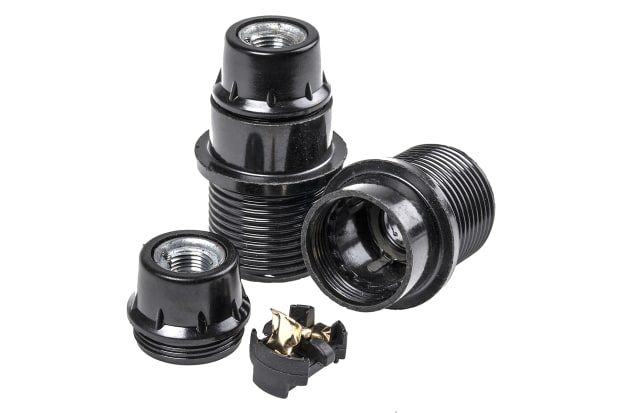
E14
Also known as small Edison screws (SES), the E14 bulb and the corresponding lamp holder have dimensions of just 14mm. Common uses include desk and ceiling lamps, as well as pygmy bulbs. These bijou, pear-shaped bulbs are used in decorative and sign lighting.
E40
This is the giant of the family, with a huge 40mm socket. Also known as GES bulbs, or Goliath Edison Screws, these high-powered bulbs and the corresponding lamp holders are used in demanding commercial and industrial settings.
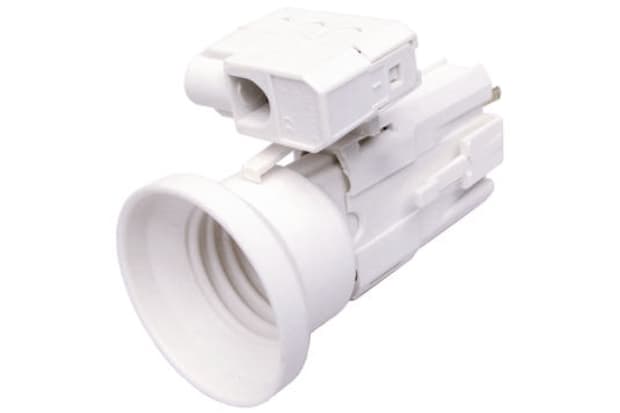
E27
The E27 lamp bulb and holder is the big brother of the E14, with a chunky socket 27mm across. They are widely used for indoor and outdoor lighting purposes.
B15
The B15 bulb and lamp holder is one of the smaller bayonet cap designs, commonly used in table lamps. They are the smaller counterpart of the standard B22 bulb and lamp holder.
Lamp Fitting Materials
Lamp fittings are made from a variety of heat-resistant materials because they need to withstand the high temperatures generated by most bulbs. The principal materials used to make lamp holders are as follows:
- Metal - for example, brass and copper lamp holders
- Plastic lamp holder fittings and sockets - the polymers (synthetic materials) polycarbonate (PC), polybutylene terephthalate (PBT) and phenol-formaldehyde (phenolic)
- Ceramic - for example, porcelain lamp holders
How to Wire a Lamp Holder
If you have purchased a lamp holder kit for assembly, it is important to proceed cautiously when you reach the wiring stage. Wiring an electrical device poses obvious risks so speak to a professional if you are in any doubt.
Learn how to wire a plastic or metal lamp holder below:
- Attach your lamp fitting to the holder - pull the thread through and tighten the screw at the bottom of the holder to lock it into place
- You will normally then have two wires to attach to the holder - a live wire, typically brown, and a neutral wire, typically blue. Insert these into either socket in the connection unit and tighten the screws
- Attach the connection unit to the upper part of the lampholder. This should snap firmly into place but if you encounter resistance move it in the opposite direction to apply, or check that the screw attaching the unit to the holder is tight
- Assemble the full bulb holder, again ensuring that the parts are screwed or snapped in the correct direction
Lamp Holder Suppliers
TE Connectivity
With a range of options and features available, shop lamp holders from leading brand TE Connectivity.
S Lilley & Son
Available with multiple thread sizes and base types, browse the full range of lamp holders from S Lilley & Son.
JKL Components
JKL is a leading producer of LED lighting equipment. Click through to browse the full range of lamp holders and shop online.
Orbitec
Browse the various types of lamp holder available from Orbitec and discover the most suitable product for your requirements.
FAQs
Is B22 the Same as E27?
These two bulb types are quite similar. Both provide warm, steady light in commercial and domestic settings and they are used for many of the same purposes. However, they feature different bases. The B22 has a push-and-twist bayonet cap while the E27 has a revolve-to-insert Edison screw.
What is the Difference Between E14 and E27?
These are both Edison screw bulbs, with that distinctive threaded base. The difference lies in the diameter of the socket, which is indicated by the number. The smaller E14 has a socket diameter of 14mm, while its larger counterpart has a diameter of 27mm.
What is an E14 Light Bulb?
The E14 is one of the most widespread twist-in, Edison screw bulbs in contemporary use. It is a smaller variation of the E27, with a socket diameter of 14mm.
Is E7 the Same as ES?
Not quite. ES is short for Edison screw - these are the threaded bulb bases that are screwed into lamp holders to secure the bulb. They are named after their inventor, legendary 19th-Century engineer Thomas Edison. E7 bulbs are one smaller size of ES bulb, with a socket diameter of 7mm. These typically have a candle-like shape.
